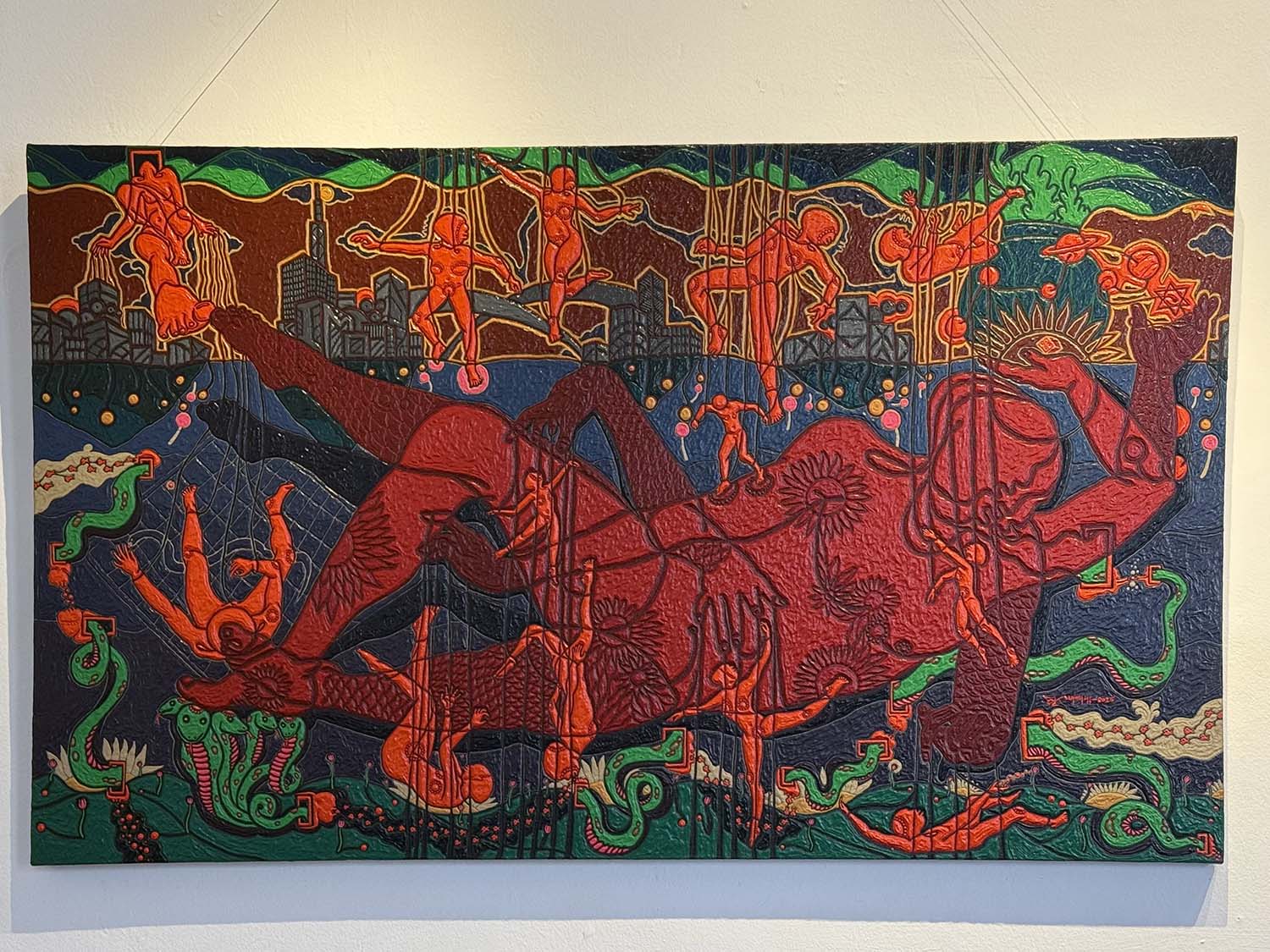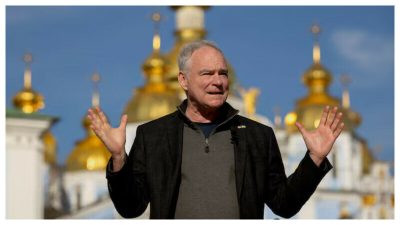Nepal, June 20 — Freedom of expression is what both unites and separates humankind. Does one manifestation of this expression cloud the other, create division, or does this limitlessness support a collective human experience? Too frequently in the modern age do differing opinions create tension between individuals rather than provide a source for growth and learning.
Siddhartha Art Gallery’s ‘Amalgam 2025’, showcases a myriad of themes ranging from political activism, environmental justice, religious freedom and suppressed emotion. ‘Amalgam 2025’ continues the legacy of community-based dialogue established by the gallery director, Sangeeta Thapa. ‘Amalgam’, a shortened form of amalgamation, signifies the act of making anew through combination. The exhibit features 61 artists of varying ethnic origins, thus accentuating Nepali creators. The mixed-media show displays diverse textures, colours, and scales through paintings, etchings, prints, wood sculpture, and drawings etc.
Upon entering the gallery, the viewer is immediately met with Rajan Pant’s complimentary acrylic paintings ‘Terai Village I’, and ‘Terai Village II’. Though they are depictions of Nepali plains, the vibrant colours allow for an exploration of locations and create a sense of imaginary familiarity. It’s as if the figures could be anywhere in the world exploring a whimsical landscape. Pant depicts scenes of movement and liveliness, using figures in motion and the dynamic nature of his objects, sand, sky and trees.
Walking clockwise through the gallery leads to an untitled acrylic painting by the veteran artist Shashi Bikram Shah. Upon first glance, the muted colour palette of the work may make it difficult to digest. However, a more thorough observation reveals its true power. This piece features sullen men and several horses. The head of the central horse, as it is closest to the distraught figures, comes out of a large shadow and appears white. The white horse is a recurring symbol throughout Shah’s works and many belief systems, and it is interpretable as a motif for the salvation of humanity. For Christians, a rider on a white horse brings good over evil; for Hindu individuals, the Kalki avatar (also a rider on a white horse) appears during a time of moral decay to restore righteousness. The head of the saviour horse faces a group of civilians, prepared to initiate the transition from evil to good.
Tenzin Rigdol, formerly displayed at the Metropolitan Museum of Art in New York, has two works in the show. First, the viewer is met by a simplistic sea of purple and blue waves titled ‘Geometry of Emotions’, overlapping but never muddled. Rigdol’s intense precision and lack of a focal point make it look artificially generated despite being executed organically. The pulsating curves are emphasised in the foreground through a gradation of colour, creating the illusion of falling or swimming in the painting.
His photograph ‘Matchstick’ is positioned beside the painting, which captures the spontaneous instance of lighting a match. Contrasting with his painting, the photograph has a heavy feel. At the centre of this figure rests a vajra. The matchstick and vajra similarly connote enlightenment, strength, and clarity of the mind. The symbols exist on the same line of continuity in the photograph, while there are no other discernible objects present in the image. The blurred and hidden background leaves an observer questioning the remaining unseen surroundings.
Completing a loop around the first floor leads to the first of two works by Manorma Khatri. The smaller of the two is entitled ‘Baba’. Baba, in this context, is a colloquial name for an ascetic. This pattern is centred around a dark spiritual face, resembling a mask. Ritual masks represent gods, deities, animals, or elements of folklore, often a centralised component of storytelling and performance.
Accompanying ‘Baba’, another work by Khatri, ‘Rama’, resides just above the staircase to the second floor. Surrounded by a mandala, the deity Rama is the embodiment of morality and righteousness. When asked about the centralisation of men in her works, Khatri states they are an homage to the grounding nature of father figures, as she tragically lost hers when she was young. Much like the purpose of ‘Amalgam 2025’ the mandala signifies continuity, and is represented both in Buddhist and Hindu traditions.
As one ventures through the second floor of the gallery, they will meet a cluster of muted black and white works, a stark contrast to the vibrancy of the first floor. At the centre lies an acrylic painting by Nikhil Bahadur Shakya. The piece ‘Shree Prachandra Maha Roshana’ can be described in one word: power. Maha Roshana (a wrathfully protective deity), demonstrates intensity through his stance, the gleaming sword in his hand, and the regalia of heads enshrouding his neck and torso. At 72×54 inches the exaggerated scale contributes to its dominating energy. The impending heft of the deity in the image makes us question our own mortality as humans.
Ishan Pariyar’s ‘Co-existence’ demonstrates the beauty of highly exploited Nepali wildlife. With the Himalayas as the background, a man captains a boat shaped like a gharial, with several endangered animals standing inside the boat. Pariyar memorialises the disappearance of native wildlife, raising awareness and appreciation-however, plays it safe in terms of the palatability of the piece. It is objectively attractive but lacks a sense of risk. The artist could have more effectively highlighted the critical endangerment of the animals through more intense aesthetic choices. Regardless, each animal was painted with great care and attention to detail, giving life to this naturalistic scene.
‘Amalgam 2025’ continues into the annex. Taking up the centre space hangs Krishna Lama’s ‘Puppeteer’. The most prominent feature of this work is its intense texture. Though it is composed entirely of acrylic paint, it has a textual, 3D quality to it. The peaks and valleys of the canvas contribute to the intriguing depth of the painting. The central figure holds the sun, Earth, and stars, establishing balance between the cosmos and physical Earth system. The smaller puppets across the canvas, provide an illusion of unseen connections which predetermine our human actions. As a viewer, it feels as if you are becoming immersed, or falling into the world of the unknown, of the gods, or of that which can only be felt and not seen.
Traversing the second floor of the annex reveals four paintings by Krisha Tamrakar entitled ‘Silent Boundaries’. Each set on a pink background, they portray entrapped femininity. Tamrakar has captured the concept of grihasthi, a Nepali noun for domestication, usually assigned to the housewife. Each of the encaged objects visualises the limited activities which can be conducted by a woman. The bags appear worn out, limp and lifeless, as if they have been used repeatedly with no rest. If the other two objects were painted in as much distress, Tamrakar could have more effectively alluded to the message of recurring utility. Drawing from everyday life, the simplicity of these objects reaffirms the direct restrictions and limited lifepaths of women, caused by a misogynistic world.
In Kailash K Shrestha’s ‘Occurrence after Democracy 2020, Nepal’ a bony figure merges from a stormy sky, stepping on a city proportional only to insects. The clothing of the politician signifies his status as a Brahman, representing elitism, purity, and heteronormative masculinity; the garlands which adorn his neck demonstrate great accomplishment (such as winning an election), and most importantly unyielding power. With a red string following from head to toe he is bound by blood to his personal agenda. Shrestha makes a commentary on the selfish nature of the nation’s political system, but simultaneously glorifies the politician with his attractive depiction.
Though a viewer may become lost entering ‘Amalgam 2025’, due to its lack of an overarching theme, closer inspection reveals that the unifying factors are ideas important to the artists themselves. Accurately named, the show is surely an amalgamation of ideas, highlighting many themes at once. Leaving the exhibition, one may be overwhelmed by the influx of new ideas, curious for what other sentiments artistry can provoke.
Amalgam 2025
Where: Siddhartha Art Gallery, Babermahal Revisited
When: June 8 to July 8
Time: Sunday to Friday, 11:00 am to 5:00 pm, Saturday 12:00 pm to 5:00 pm
Entry: Free













